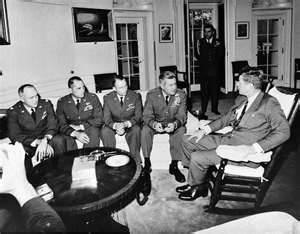The Cuban Missile Crisis: World War III Narrowly Averted
Part 2: Nearly a War
The president made a nationwide address on television on October 22, announcing the presence of the nuclear missiles in Cuba and calling for the Soviet Union to remove them. He then announced the blockade (calling it a "quarantine"), promising that ships found to be approaching Cuba and carrying offensive weapons would be forced to turn back.
On October 25, in an emergency meeting of the United Nations Security Council, U.S. Ambassador Adlai Stevenson revealed spy photos that proved the existence of the nuclear missiles in Cuba. The response from Soviet Ambassador Valerian Zorin was by no means a concession. In fact, neither country was budging — in public. Behind the scenes, however, officials of both the U.S. and U.S.S.R. were negotiating a non-military resolution to the crisis. Through various back channels, the two countries agreed to end the standoff with a tradeoff — the Soviet Union would remove its missiles from Cuba, and the U.S. would remove its missiles from Turkey. On October 28, Kennedy and Khrushchev announced that the Soviet missiles would leave Cuba. But no mention was made of the American missiles in Turkey. The only public announcement of missiles being removed was from the Soviet Union. The U.S. "quarantine" continued, turning into a verification mission that the Soviet Union was keeping its promise to remove the missiles. The "quarantine" ended on November 20. The dismantling of the American missiles in Turkey began as well, and the missiles were removed a few months later. No missiles were fired in the end, from any country. Estimates at the time of casualties had the two nations traded nuclear missiles were in the hundreds of millions. The fear factor was definitely high, especially in the U.S. The only leader to survive in power for more than two years was Castro. Kennedy was assassinated in 1963, and Khrushchev was ousted as Soviet leader the following year. Castro relinquished power to his brother only in 2008. One of the lasting results of the Cuban Missile Crisis (called the October Crisis in Cuba and the Caribbean Crisis in the Soviet Union) was the creation of the Hotline, a direct phone line from Moscow, the capital of the Soviet Union, to Washington, D.C. First page > Cold War Backdrop > Page 1, 2 |
|
Social Studies for Kids
copyright 2002–2024
David White



 On October 19, President Kennedy created a group called the Executive Committee of the National Security Council (EXCOMM) to discuss the American response. All nine members of the Security Council, plus five other key advisers, were on this group. Strategies discussed ranged from ignoring the situation entirely to full-scale invasion of Cuba. Kennedy chose a blockade.
On October 19, President Kennedy created a group called the Executive Committee of the National Security Council (EXCOMM) to discuss the American response. All nine members of the Security Council, plus five other key advisers, were on this group. Strategies discussed ranged from ignoring the situation entirely to full-scale invasion of Cuba. Kennedy chose a blockade. Cuban and Soviet leaders continued to deny the existence of offensive missiles and threatened retaliation if Soviet ships were fired on or if Cuba were invaded. Responses flooded in from other countries, with China expressing full support Cuba and Western nations supporting the U.S. but worrying that the Soviet response might involve a takeover of Berlin. Khrushchev, meanwhile, warned of war.
Cuban and Soviet leaders continued to deny the existence of offensive missiles and threatened retaliation if Soviet ships were fired on or if Cuba were invaded. Responses flooded in from other countries, with China expressing full support Cuba and Western nations supporting the U.S. but worrying that the Soviet response might involve a takeover of Berlin. Khrushchev, meanwhile, warned of war.

